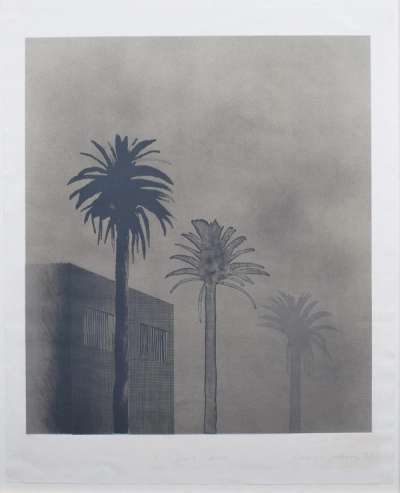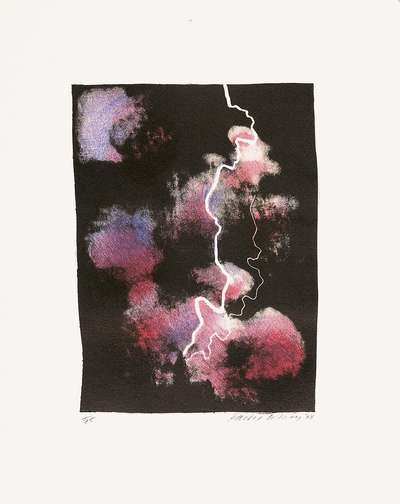Modern Ukiyo-e: David Hockney's The Weather Series

 Small Study Of Lightning © David Hockney 1973
Small Study Of Lightning © David Hockney 1973
David Hockney
654 works
David Hockney's artistic journey – from his formative years in Bradford to his epoch-defining presence in Los Angeles – reveals a profound transformation, heavily influenced by a diverse array of artistic styles and masters. His deep engagement with the vibrant, revolutionary approaches of artists like Pablo Picasso and Impressionists such as Claude Monet has shaped his unique visual language. In The Weather Series, Hockney's fusion of Japanese Ukiyo-e with Western artistry comes to the forefront, demonstrating his command over intricate detailing, colour dynamics, and conveyance of emotional depth.
This series represents a significant contribution to contemporary art at large, inspiring modern artists to blend diverse cultural narratives and explore new realms of emotional expression and thematic depth. Through The Weather Series, Hockney builds on the legacy of Impressionists and cements his status as a luminary in modern art, continuously pushing the boundaries of artistic innovation and cultural dialogue.
David Hockney, A Modern Master
Hockney is one of the most iconic and successful artists living today. His early years in Bradford and London were pivotal in shaping his artistic voice, as he matured his craft amidst the vibrant 1960s scene. His openness about his identity and his groundbreaking work in LGBTQ representation set a new precedent in the art world, while his move to Los Angeles in 1964 marked a significant change in his style. The Californian landscape, especially its swimming pools, influenced some of his most renowned works. Celebrated for his use of vivid colours and unique perspectives in a variety of mediums, Hockney has achieved record-breaking prices at auction, solidifying his status in the art market.
Hockney's artistic inspirations include a range of influential artists and styles from around the world. Notably, he has been inspired by the works of Picasso, known for his revolutionary approaches to form and perspective. Hockney's fascination with capturing landscapes and experimenting with perspective can also be linked to influences from impressionist painters like Monet, particularly evident in his later, more colourful works. Additionally, his exploration of colour and light has parallels with the works of modernist artists such as Henri Matisse. These diverse influences have contributed to Hockney's unique and evolving artistic style.
Hockney is widely recognised as one of the most successful living artists of our time. His remarkable career, spanning over six decades, has seen him continually reinvent and adapt his style, making significant contributions to the art world.
Traditional Ukiyo-e and its Impact:
Ukiyo-e, a distinctive school of Japanese painting and printmaking, originated in 17th-century Yedo (now Tokyo). The term, which translates to "pictures of the floating world," encompasses genre paintings that vividly depict life and customs in and around Edo during the Edo period (1615 - 1868), as well as landscapes of the period. This artistic style captures the transient beauty and daily experiences of the time, reflecting a unique blend of cultural and social elements of that era. Stylistically, Ukiyo-e is characterised for its emphasis on flatness, use of bright colours and its bold outlines. These compositions often present figures within a singular depth plane, emphasising vertical and horizontal relationships and detailed patterns, especially in clothing. Ukiyo-e compositions frequently employ asymmetry and unique perspectives, such as aerial views, creating a sense of spontaneity through partially cropped elements.
The technique of sharply defining colour contours stands in stark contrast to the modulated colours typical of Western art traditions post-Renaissance. This style juxtaposes complex, ostentatious patterns and dynamic poses with traditional Japanese aesthetics. It diverges from more ascetic principles like wabi-sabi and shibui, leaning more towards the flamboyant and stylish iki. Ukiyo-e's approach to perspective, which blends Western geometric and traditional Asian techniques, creates a unique depth and expression in its works. This multifaceted approach to perspective is exemplified in works like Hokusai's The Great Wave Off Kanagawa, which showcases a sophisticated interplay of foreground and background elements. The Great Wave has become one of the most recognisable works in art history, amplifying Ukiyo-e’s impact around the world and influencing Western Impressionists and Post-Impressionists with its distinct use of colour and composition. Its emphasis on everyday life and nature resonated across cultures, and the style’s innovative perspective techniques inspired many European artists. Ukiyo-e's legacy is evident in its enduring popularity and influence on contemporary art forms, including in Hockney’s work.
The Japanese Influence on Impressionists and Post-Impressionists
Japanese art, particularly Ukiyo-e woodblock prints, exerted a profound influence on the Impressionists and Post-Impressionists in Europe during the late 19th century. The opening of Japan to the West in the 1850s brought a surge of Japanese artworks into Europe, captivating artists with their unique aesthetics and techniques. Impressionist and Post-Impressionist painters like Monet, Edgar Degas and Vincent van Gogh were particularly drawn to the bold colours, flattened perspectives and decorative patterns prevalent in Ukiyo-e prints; these elements were markedly different from the traditional European focus on realism and perspective of the time.
The Japanese influence is evident in the Impressionists' experimentation with light, colour, and depiction of everyday subjects. For instance, Monet's series of water lily paintings shows a clear inspiration from Japanese art in its use of natural motifs and a flattened perspective. Similarly, Degas incorporated Japanese-style diagonal compositions and asymmetry in his works, diverging from the conventional compositional methods of his compatriots. Post-Impressionists openly acknowledged this influence: Van Gogh's Almond Blossom and Plum Park In Kameido are prime examples of this, where he employed vibrant colours, bold outlines and a flatness of form, directly mirroring the Japanese style and motifs.
This influence extended beyond stylistic elements to a more holistic artistic philosophy: the Impressionists and Post-Impressionists embraced the Japanese ethos of finding beauty in everyday life, a key tenet of Ukiyo-e art. This shift contributed to a broader artistic movement in Europe, known as Japonisme, which permeated various artistic fields including painting, printmaking, and decorative arts. The impact of Japanese art on these European movements was a significant factor in the evolution of modern art, bridging Eastern and Western artistic traditions and fostering a more global perspective in art.
Hockney’s The Weather Series: Ukiyo-e Reimagined
Hockney’s The Weather Series is a testament to the artist’s genius in blending traditions from around the world. Here, he mixes Eastern and Western art traditions, drawing heavily from the Japanese Ukiyo-e woodblock printing style, particularly masters like Hokusai and Hiroshige. This series is an embodiment of Hockney's intricate detailing and emotional expression, as pieces like Snow and Rain reflect Ukiyo-e’s depth in its portrayal of nature. Mist and Dark Mist, on the other hand, show the essence of Japanese Ukiyo-e juxtaposed with Los Angeles' palm trees, icons of Americana. In Lightning, Hockney dramatically uses colour to shift moods, contrasting the series' generally subdued palette with a burst of intensity and showcasing his mastery of colour to evoke a particular emotion.
In contrast, other works in the series are monochrome, illustrative of a turbulent period in the artist’s own life. The series might not have existed were it not for a personal turning point in Hockney's life, a breakup in the lead-up to a trip to Japan in 1971. This trip marked a significant creative and personal shift, infusing his work with Japanese artistic nuances. Hockney's introspective approach is evident in Wind, where he revisits elements from his earlier work, Picture Of Melrose Avenue In An Ornate Gold Frame, recontextualising them in a new light. Even the Sun, a landmark of his work since his move to California in 1964, is nearly absent from the series, trickling through closed shutters instead.
Technically, Hockney was innovative in his printmaking technique, combining lithography and screen printing. His collaboration with master printers at Gemini G.E.L. in Los Angeles, began in this series, would continue to influence his later collections and shape the mixed-media printmaking landscape for decades to come.
The Weather Series: Impact and Legacy
Hockney's Weather Series has significantly influenced the contemporary art landscape. This series, melding the intricate detailing of Japanese Ukiyo-e with Western artistic principles, has spurred a wave of cross-cultural exploration among modern artists. Its impact is seen in the way it encourages a harmonious blend of different art forms, pushing the boundaries of traditional art and fostering a respectful global artistic dialogue. Hockney’s work, particularly this series, has been pivotal in showcasing how art can transcend cultural barriers, inspiring artists to weave diverse cultural narratives into their creations.
It has further carved a niche in the art world by highlighting the significance of emotional depth and narrative, even within the “mechanical” medium of printmaking. This aspect of Hockney's work has been especially influential in inspiring contemporary artists to delve into their cultural heritage while incorporating global influences. The series is another example of a long line of artistic innovation within Hockney’s career, typical of his blending technique and thematic richness. It is also illustrative of the way that Hockney’s personal life bleeds into the canvas, allowing the viewer a glimpse into the artist’s mood at the moment of the work’s creation. Its legacy in shaping modern art movements and promoting cultural interchange is undeniable, continuing to inspire and challenge artists in their creative pursuits.





















